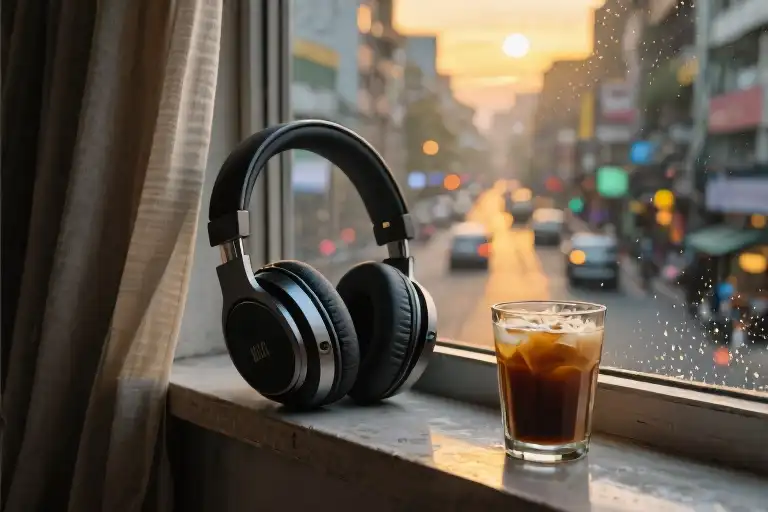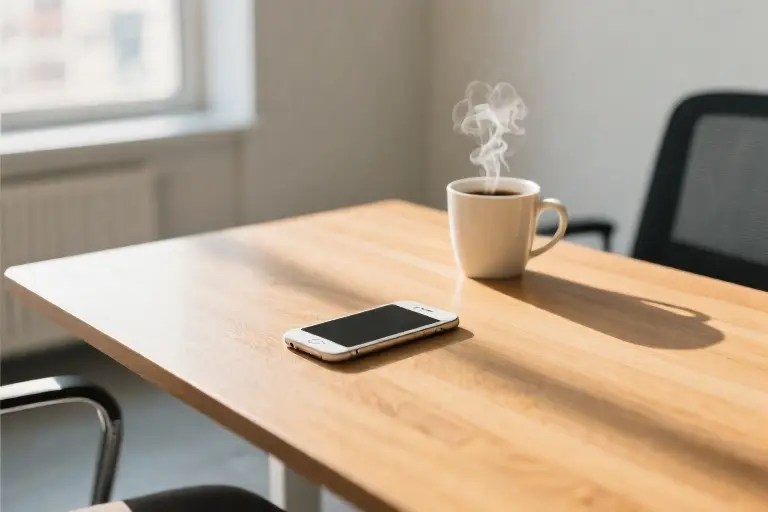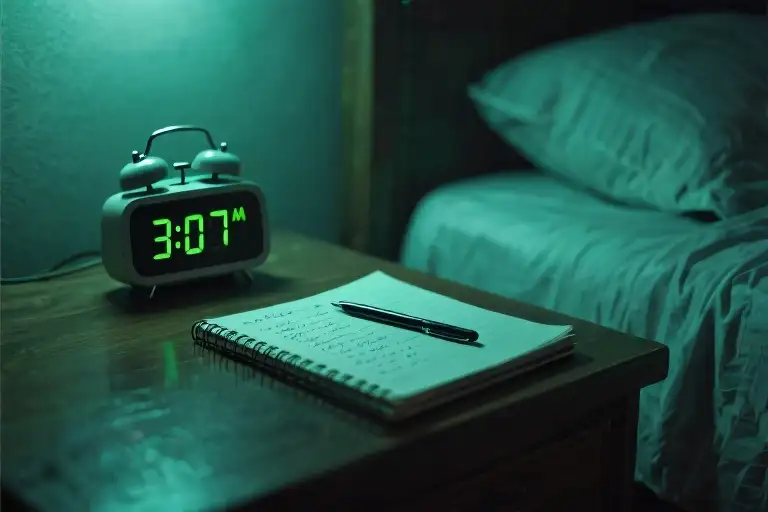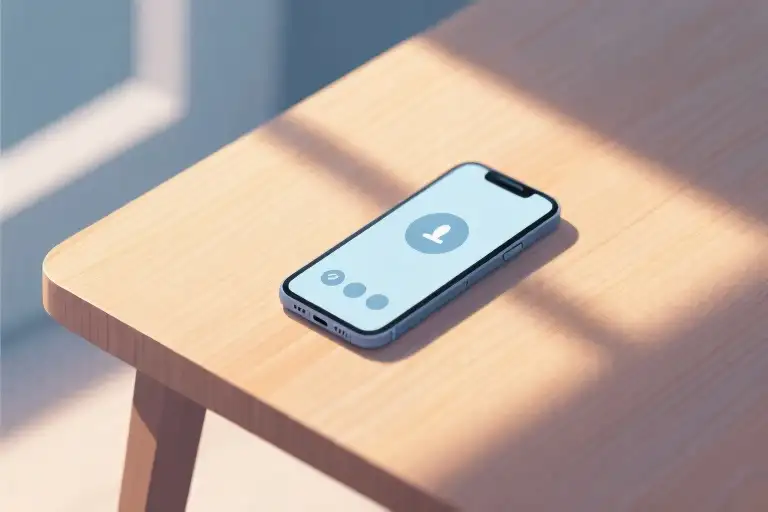The morning symphony of Jakarta begins not with birdsong, but with the relentless growl of motorcycle engines and the sharp percussion of car horns. I cradle my iced coffee like a talisman, its bitter chill seeping through my fingers as the condensation mimics the sweat on my brow. Through my fifth-floor window, the city stretches out—a living organism pulsing with exhaust fumes and impatient energy.
Then my phone buzzes. A single line floats on the screen, stark against the WhatsApp blue: “I’m pretty concerned about your mental health.”
Three months ago, this same friend had cheered when I announced my move to Jakarta, declaring I was “embracing my inner Ted Mosby”—a reference to the hopelessly romantic architect from How I Met Your Mother who thrived in New York’s chaos. We’d laughed then. Now his text hangs in the air like monsoon humidity, equal parts touching and unsettling.
The irony isn’t lost on me. Ted Mosby’s brownstone fantasies involved rooftop proposals and meaningful coincidences. My Jakarta reality features two-hour commutes for coffee meetings that could’ve been emails, and a studio apartment where the shower occasionally electrocutes me. The city tests you in ways no urban planning degree prepares you for—its traffic doesn’t just steal time, it devours optimism in 15-minute increments.
Yet here’s the paradox: when I finally get a day without obligations, I don’t rush to explore like the ideal urbanite. Instead, I burrow deeper. The bed becomes an island, my headphones a forcefield against the motorbike crescendos below. Scrolling through my seventh TikTok compilation of Succession memes, I realize this is my version of self-preservation—a digital hibernation where Spotify playlists and movie marathons stand in for therapy sessions.
Jakarta demands constant performance. You’re either hustling or being left behind in the literal dust of construction sites. No wonder my friend’s concern arrived like an unprompted life raft. In this city that never stops moving, choosing stillness becomes its own radical act—one that looks suspiciously like surrender to outsiders.
Perhaps that’s the real Ted Mosby delusion: believing we can romanticize urban exhaustion indefinitely. The truth hides in my unanswered text thread, in the half-finished thought: “Especially with the absence…” of what? Sleep? Quiet? The ability to distinguish between a bad day and burnout? The city keeps draining, and we keep pretending the cracks aren’t showing—until someone points out they’ve become visible from space.
When Jakarta Hits Mute: Building Parallel Universes in Noise-Canceling Headphones
The motorcycle engines outside my window roared to life at 5:47 AM – I know because my noise-canceling headphones failed spectacularly at that exact moment. In that jarring transition between silence and chaos, I understood why WHO considers sustained noise above 55 decibels a serious health threat. Jakarta averages 85.
The Science Behind the Static
Research shows chronic noise exposure:
- Reduces cognitive performance by 25% (University of Michigan, 2022)
- Increases stress hormones by 30% within 15 minutes (Journal of Environmental Psychology)
- Disrupts sleep cycles even after noise stops (NIH study on urban dwellers)
That explains why after particularly loud commutes, I’d stare at my laptop like it was written in hieroglyphics. The city wasn’t just draining my energy – it was eroding my ability to think.
The Hermit’s Survival Kit
After six months of trial and error, these became my urban sanctuary essentials:
- Sony WH-1000XM5 headphones ($398)
- Pro tip: Pair with brown noise (better than white noise for urban frequencies)
- Blackout curtains + Philips Hue lights ($150 total)
- Creates instant “night mode” regardless of Jakarta’s eternal daylight
- Textured blanket + weighted eye mask ($45)
- Tactile grounding when the world feels too loud
- Old-school MP3 player ($79)
- Digital detox secret: No notifications, just music
- Pocket-sized notebook ($12)
- For capturing song-inspired daydreams when algorithms overwhelm
Total investment: $684 (or about 3 months of Jakarta therapy co-pays)
The Parallel Universe Playbook
Here’s how I transform my 20m² room:
- Auditory escape: Lana Del Rey’s Norman F Rockwell* + brown noise = instant California coastline
- Visual shift: Project Before Sunrise on the ceiling = Budapest streets replace my view of traffic
- Sensory swap: Peppermint oil + cold compress = mountain air illusion
It’s not perfect – sometimes a Gojek driver’s horn pierces through my imagined Parisian café. But for those hours when it works? Priceless.
“The quiet moments we steal from noisy cities aren’t escapes – they’re resistance.”
The Ted Mosby Syndrome Diagnosis
That text message from my friend kept replaying in my mind like a Spotify ad you can’t skip. “I’m pretty concerned about your mental health” – seven words that somehow carried more weight than Jakarta’s infamous traffic jams. It was ironic coming from the same person who’d compared my move to the city to “embracing the Ted Mosby within me.”
When Sitcom Dreams Meet Urban Reality
For those who haven’t binge-watched How I Met Your Mother, Ted Mosby represents the romanticized version of city living – the architect with a perfect loft, endless dating adventures, and friends who always have time for brunch. Jakarta Ted, however, looks more like:
- 6:30 AM: Wakes up to motorcycle symphony (not the romantic kind)
- 7:15 AM: Checks bank app, winces at rent deduction
- 8:45 AM: Still in traffic, practicing deep breathing (75% rage, 25% actual mindfulness)
- 10:00 PM: Collapses on bed, swears tomorrow will be different
This cognitive dissonance between expectation and reality creates what I’ve started calling Urban Adjustment Disorder – that specific flavor of mental exhaustion that comes when your city life looks nothing like the movies.
Jakarta’s Top 3 Soul Crushers
Through extensive fieldwork (read: daily survival), I’ve identified the trifecta of urban burnout triggers:
- The Commute Gauntlet
- Average Jakarta worker spends 235 hours/year in traffic (that’s 10 full days)
- Pro tip: Create “commute playlists” with songs exactly matching your route duration
- The Rent Paradox
- Paying Manhattan prices for what locals politely call “character apartments” (translation: questionable plumbing)
- Mental hack: Frame exposed brick walls as “industrial chic”
- Air Quality Roulette
- Waking up to decide: “Is today a mask day or an asthma inhaler day?”
- Silver lining: The haze makes sunsets Instagram-worthy
Urban Survival Self-Assessment
Take this quick test to diagnose your city fatigue level (answer honestly – no one’s judging except maybe your therapist):
| Symptom | Level 1 | Level 2 | Level 3 |
|---|---|---|---|
| Commute Reactions | Sighs at Google Maps | Talks to GPS like a therapist | Develops emotional attachment to toll booth operators |
| Social Battery | Cancels plans occasionally | Has “I’m sick” auto-text ready | Forgets what friends look like |
| Apartment Feelings | “It’s cozy!” | “At least the roaches pay rent” | Names dust bunnies |
| Work Stress Relief | Weekend brunches | Midnight online shopping | Imaginary arguments with boss in shower |
Scoring:
- Mostly 1s: You’re still Ted Mosby (bless your heart)
- Mostly 2s: Welcome to Urban Adjustment Disorder
- Mostly 3s: Please take a mental health day immediately
The Jakarta Hustle vs. Reality
What makes this particularly jarring is Jakarta’s unique pressure cocktail:
- Tropical Time Warp: 90% humidity makes everything feel urgent yet impossible
- Digital Whiplash: Gojek drivers move faster than your career progression
- Social Media Mirage: Everyone else’s life looks like a tourism ad
Yet here’s the paradoxical truth my friend’s text made me realize: Concern means connection. Even in our most isolated moments, someone notices. Maybe not in a sitcom-perfect way, but in that messy, real-life fashion where a random text becomes a lifeline.
So if you find yourself today:
- Staring at your ceiling fan wondering if it judges you
- Calculating how many avocados you’d need to sell to quit your job
- Googling “how to become a shepherd” at 2 AM
Know this: You’re not failing at urban life. You’re just human in a system that often forgets what that means. And maybe – just maybe – that friend’s awkward check-in is the universe’s way of saying your Ted Mosby era isn’t dead… it’s just on pause for renovation.
The Renaissance in My Room
Turning a Studio Apartment into an Art House Cinema
The flickering blue light from my laptop screen casts shadows on the ceiling as I prop up against three mismatched pillows. With a TikTok filter overlay, the water stain above my air conditioner transforms into an abstract art installation. This is how urban hermits curate their sanctuaries – not with expensive decor, but with digital alchemy and desperate creativity.
Step 1: Light Manipulation
- Dimmable LED strip lights (IDR 120,000 from Tokopedia) set to ‘dusk amber’
- Phone projector app (Nebula works best) beaming Van Gogh’s Starry Night onto blank wall
- Bonus hack: Hang a prism in the window to scatter rainbow patterns during golden hour
Step 2: Sensory Redirection
| Sensory Input | Replacement Therapy | Cost |
|---|---|---|
| Traffic horns | Brown noise playlist | Free |
| Stale AC air | Peppermint oil diffuser | IDR 75,000 |
| Hard flooring | Memory foam bath mat | IDR 89,000 |
Tactile Therapy Toolkit
That moment when your shoulder muscles unclench as you sink into the perfect pillow arrangement – that’s urban survival poetry. My tactile defense system includes:
- The Icebreaker
- Gel-filled eye masks kept in the freezer
- Pro tip: Use during 3pm energy crashes for instant reboot
- Weighted Comfort
- DIY rice sock (microwave for 2 minutes as muscle relaxant)
- Strategically placed on tense shoulders during movie marathons
- Texture Rotation
- Alternate between fuzzy blankets and crisp percale sheets
- Creates subtle sensory variation to prevent numbness
Anatomy of a Meltdown Playlist
My Emergency Emotional Protocol music sequence follows neuroscience principles:
Phase 1: Acknowledgment (4-6 minutes)
- Breathe by Fleurie (slow tempo matches resting heart rate)
Phase 2: Catharsis (8-12 minutes)
- All My Friends by LCD Soundsystem (builds then releases tension)
Phase 3: Recovery (15+ minutes)
- Rises the Moon by Liana Flores (gentle melodic reassurance)
Progression Science:
- Tempo increases 8-12 BPM per song then drops sharply
- Key changes move from minor to relative major
- Lyrics transition from “I” statements to universal themes
The Hermit’s Surprise Benefit
During these curated escapes, I discovered an unexpected perk: selective productivity. When the brain isn’t fighting traffic noise or social performance, creative work flows differently. Last Tuesday’s “lazy” movie day yielded:
- 3 solved work problems during end credits
- 1 breakthrough shower idea post-film
- 12 quality pages read during snack breaks
Maybe Ted Mosby had it backwards. The real urban wisdom isn’t in chasing the perfect metropolitan life, but in mastering the art of strategic withdrawal. Tomorrow’s agenda: testing if Pride and Prejudice (2005) works as a spreadsheet companion film.
The 108 Ways to Decode “I’m Fine”
Measuring Emotional Distance: From Read Receipts to Heart Emojis
That unread notification icon holds more weight than we admit. When my friend’s mental health check-in text appeared between work emails, I realized how urban isolation rewires our communication patterns. In Jakarta’s relentless grind, even caring messages become psychological riddles to solve.
The Semiotics of Urban Loneliness
We’ve developed an entire visual vocabulary to mask emotional exhaustion:
- The delayed 3-hour “👍” reply = “I’m drowning but don’t want to explain”
- The midnight Instagram story song post = covert distress signal
- The strategically ambiguous “😅” = Jakarta’s universal emotional plaster
A 2023 University of Indonesia study found that metropolitan workers use 73% more ambiguous emojis than their provincial counterparts. This isn’t just digital laziness—it’s self-preservation in a city where admitting vulnerability feels like adding another item to your overwhelming to-do list.
Low-Energy Social Experiments: The Spotify Cure
When face-to-face meetups feel as daunting as crossing Jakarta’s Bundaran HI roundabout at rush hour, my friend circle invented “asynchronous hangouts” through shared playlists. Our rules:
- No commentary pressure – Just add songs when thoughts feel too heavy to articulate
- Theme coding – Use emojis as mood indicators (🎢 for emotional rollercoasters)
- Passive listening – No need to discuss; just know someone’s riding the same wavelength
This created what psychologists call “ambient intimacy”—the digital equivalent of sitting silently together in a comfortable room. My most therapeutic playlist? “Jakarta Nights We’re Not Talking About” filled with:
- Lana Del Rey’s Mariners Apartment Complex (for when the city feels like a beautiful trap)
- Hindia’s Evakuasi (local indie perfect for traffic jam existentialism)
- Radiohead’s No Surprises (the ultimate mental reset button)
The Unfinished Text: Between the Lines
That dangling message—”especially with the absence…”—haunts me more than any completed sentence could. Urban mental health struggles often live in these ellipses, the thoughts too frayed to articulate. Sometimes the most honest response isn’t words at all:
Alternative Replies When Words Fail
- Send a song link with timestamp (2:13-2:45 says it all)
- Share a meme that makes you both laugh/cry
- Use WhatsApp’s “view once” feature for raw, unarchivable honesty
Jakarta teaches us that connection doesn’t require grand gestures. A perfectly timed GIF or collaborative playlist can bridge emotional gaps when conversations feel like climbing 30 floors in a power outage. The real message isn’t in the text—it’s in the courage to send it at all.
The Choice We Make Every Morning
Your phone alarm blares at 6:30am. Before your eyes fully adjust, the soundscape of Jakarta assaults your senses – motorbike engines revving three floors below, construction drilling two blocks away, the metallic clang of your neighbor’s security gate. You haven’t even moved from your mattress, but your cortisol levels already mimic someone running late for a final exam.
This is when the daily decision materializes like a pop-up notification: Do I surrender to Jakarta’s chaos today, or claim sovereignty over my nervous system?
The Commuter’s Dilemma
Option A means joining 2.3 million other vehicles in what urban planners politely call “traffic flow management.” You’ll spend 87 minutes (Jakarta’s 2023 average commute) practicing diaphragmatic breathing while:
- Taxi drivers perform vehicular acupuncture between lanes
- Your GrabFood delivery rider texts “5 minutes away” for 27 minutes
- The AC in your TransJakarta bus impersonates a hair dryer
By the time you reach your desk, you’ll have absorbed enough honking to rewrite your brain’s threat detection system. The WHO recommends keeping environmental noise under 55 decibels; Jakarta’s average is 73. That difference explains why you feel like you’ve boxed three rounds before your first meeting.
The Hermit’s Counteroffer
Option B unfolds when you tap your Spotify icon instead of Gojek. You press play on Mariners Apartment Complex and perform the urban millennial equivalent of drawing a salt circle:
- Blackout curtains engaged
- Phone on airplane mode (except Spotify Premium downloads)
- The single fan in your kost directed at your left temple
For the next 47 minutes, Lana Del Rey’s voice becomes an auditory forcefield. When she sings “I’m your man,” you’re no longer a wage slave in a 3×3 meter rented room – you’re driving Pacific Coast Highway in a convertible that doesn’t exist. This is digital dissociation at its most therapeutic, a cognitive loophole that lets you vacation without taking PTO.
Why This Choice Matters
Neuroscience confirms what our playlists intuit: music activates the default mode network, the brain system responsible for self-reflection and mental time travel. A 2022 Nature Human Behaviour study found that just 13 minutes of intentional music listening can:
- ↓ Anxiety symptoms by 31%
- ↑ Cognitive flexibility (your brain’s “control alt delete” function)
- Activate the same reward pathways as social connection
Meanwhile, chronic traffic exposure does the opposite. University of California research links prolonged commutes to:
- ↑ Cortisol production (even after you arrive)
- ↓ Prefrontal cortex activity (where good decisions live)
- ↑ Risk of depressive symptoms by 33%
Your Turn to Choose
Tomorrow at 6:31am, your phone will present the same options. Before you autopilot into another soul-sucking commute, ask yourself:
“Is where I’m going worth how I’ll arrive?”
Sometimes the answer is yes – that client pitch or best friend’s birthday can’t be Zoomed. But on days when your nervous system feels like an overworked Gojek driver, remember: pressing pause isn’t laziness. It’s urban survival strategy.
“The best minds of my generation are thinking about how to make people click ads. That sucks.” – Jeff Hammerbacher
We can’t all quit our jobs and move to Bali. But we can reclaim the 1.3 hours Jakarta steals from us daily. Start with three intentional breaths. Then choose your soundtrack.





